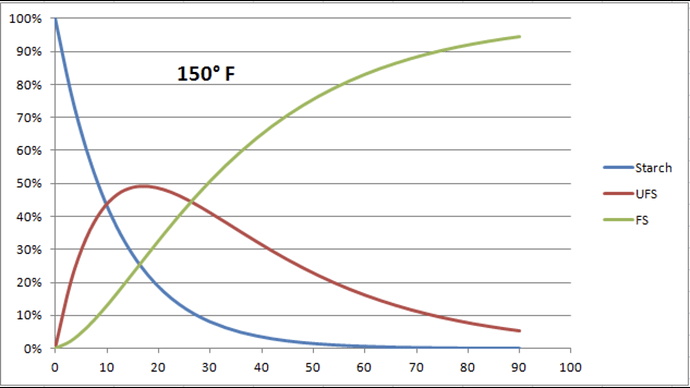So got a recipy. From one of my buddys. From europe. He says. Mash for 80 min. I did 60 min. And got a eff of. 75% and preboil wort. Of. Og. 1.045. Came out same as the 80 min mash. So why. 80 min. Unless you got all the time of the world
Am I reading this wrong but what about time? It sounds like time should increase efficiency but I haven’t experienced that not has @wilcolandzaat in his above post
These graphs illustrate that time and temperature go hand in hand towards efficiency of starch conversion and UFS (Unfermentable sugars). The X-axis in these graphs are minutes. In theory at 150F you have converted your starches at 60 mins and at 160F you have done that at 40 mins but you could keep on working on the UFS with some more time.
I do not think your hydrometer can distinguish between fermentable and unfermentable so while your efficiency will remain the same you could get a drier beer with more time. Well… according to the theory charted here.
Accordingly then time would increase both A &B which you think would change the gravity but it doesn’t. By time you mash in do the 60 minutes then drain your mashing longer than 60 anyway. Unless you do a mash out. But on the home brew scale it’s miniscule so why bother. I say just mash for 60 and be done.
I don’t think I could tell the difference between 7% UFS and 17% UFS in a hoppy beer but I probably could in a lightly hopped beer.
This shows me why there is trub, other than hops and yeast in the bottom of the fermenter… Un fermentables… But it shows you that as % and then I ask of how much?
Sneezles61
Well all those Roasted Malts, Crystal/ Carmel Malts, Honey Malts, Chocolate Malts one is adding for their unfermentable qualities. I’m not certain you are getting trub per se. But these are providing residual sugars that create that balanced malt sweetness and mouthfeel. Dextrins aren’t fermentable by most of the yeasts we use. So for this reason higher mash temperatures lead to higher FG while the OG might be the same regardless of mash temp/times as we all have experienced.
But one thing. Me have been reading in book of john palmer. The convertion. Takes place the first. 30 min of mash time. Or am i wrong. So i do understand. The graph. Displayed. Only way. Is to experiment. Next time. By doing a. 80 min mash. And see.
Sort of. As indicated in the 150F chart 90% of the conversion happens in the first 30 mins. All of these temperatures and times have to do with Beta Amylase (which is denatured at 150F) and Alpa Amylase. The higher the mash temperature the dextrinous the wort and the less attenuable/fermentable. But over longer periods of mash some enzymatic work is being done on the unfermentables from the looks of these graphs.
Very short article that really does nothing to support their theory. Anyone can create a pretty graph to support their theory but they don’t even share the data these graphs were derived from. Is that a graph of one mash session or 1,000?
I’d need a lot more convincing before I change my MO.
There are a lot of charts out there that self support this theory. None of us doubt the science of the mash. I guess what it comes down to is what is perceivable. I agree there’s no data in that article and I won’t be increasing my mash times. There are plenty of research papers out there however. As usual Brulosophy helps distill what can be tasted.
https://brulosophy.com/2018/06/21/mash-length-60-minutes-vs-20-minutes-the-bru-club-xbmt-series/
https://brulosophy.com/2018/01/08/mash-length-overnight-vs-60-minutes-exbeeriment-results/
I think a lot of multi-step and possibly mash length come from times when grains, malting, and mashing weren’t as refined as they are today so there are practices that are maintained to this day for some.
You couldn’t leave it alone.
I would agree with @squeegeethree in that most times come from when the malts and mash weren’t as refined. From my understanding you can have most conversion done within 30 mins. But, I want ALL conversion. This could make the difference between the beer being sweet or dry. Plus I want the sugar that paid for.
Sure you could do an iodine test at 30 mins and then every 5 mins later and move to your next process. But then what if you have a false positive? Or, you could take the cheap insurance and just wait the 60 mins.
The length can increase efficiency as it allows the enzymes to work breaking the starches down, so essentially you get more sugar. Often drier styles benefit from a longer mash due to this. And, I hold my American Lagers for 90 mins.
In some commercial breweries they’ll actually begin their lauter/sparge after 30 mins as they will still get conversion. It can be very difficult, if not near impossible, to get that amount of mash up to mashout temps. So if you want to maintain a certain amount of body you start running off and allow the remainder of conversion to do so while sparging.


